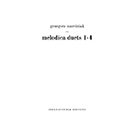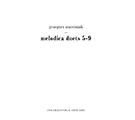Melodica Duets
Melodica Duets is a journey into the sound world of melodica and a search for its idiomatic tone. Formally, the music is designed as a set of solos to be performed asynchronously by two players. These duets can also be performed solo, with pre-recorded accompaniment. Both manners of performance of Melodica Duets embraces a key characteristic of the melodica: its unstable and day-to-day fluctuation in tuning.
Was there a delay? – someone asked me after a concert – No, there wasn’t – I said – that’s just how two melodicas sound when playing the same thing. Here, I’ll show you…
In general, cheap melodicas won’t stay in tune for long; and the longer they are played, the more out-of-tune they become. Although cleaning the reeds slows this process, the cheaper models inevitably reveal how the individual reeds in the instrument begin “to live a life of their own”. Once this process starts, the effect one gets when playing the same note on two different instruments is similar to an accordion’s musette register – similar but not the same. Some reeds become less in-tune than others but in the end, there is an element of unpredictability to how a particular note, or combination of notes, will sound when played together on two different instruments.
The key is dynamics and airflow control
I decided to take a deeper focus in exploring melodica in summer 2018. I was playing it already with my band Omega Impact for some years, but exploring the instrument at softer dynamics and taking a more homophonic, as opposed to a melodic, approach revealed quite a new world of sound and playing experience. It is also important to note that, at that time, my way of handling the instrument changed after seeing a video of Jon Batiste playing his melodica without a mouthpiece. Applying the simple observation of blowing directly into the instrument, as part of my practice, gave me more control over the airflow; and this also made it possible to explore sounds made by playing and singing at the same time.
Sounds like synth
Though it may be far-fetched, I see Melodica Duets as a part of tradition rooted in the 16th & 17th century English consort music – i.e., the tradition of playing in an ensemble of instruments from the same family and performing in rooms or private apartments rather than concert halls. Also, in my mind these duets respond to pieces such as Jürg Frey’s String Quartet No. 2, Cyril Bondi & D’Incise’s Kirari-Kirari, as well as Ellen Arkbro’s For Organ And Brass. I also see a distant connection with this music, with respect to its intimacy of performance, to the female duet tradition of Inuit throat singing. Lastly, Melodica Duets extends from a convention in symphony orchestras of arranging woodwind instruments in pairs.
Grzegorz Marciniak
March 2022
Was there a delay? – someone asked me after a concert – No, there wasn’t – I said – that’s just how two melodicas sound when playing the same thing. Here, I’ll show you…
In general, cheap melodicas won’t stay in tune for long; and the longer they are played, the more out-of-tune they become. Although cleaning the reeds slows this process, the cheaper models inevitably reveal how the individual reeds in the instrument begin “to live a life of their own”. Once this process starts, the effect one gets when playing the same note on two different instruments is similar to an accordion’s musette register – similar but not the same. Some reeds become less in-tune than others but in the end, there is an element of unpredictability to how a particular note, or combination of notes, will sound when played together on two different instruments.
The key is dynamics and airflow control
I decided to take a deeper focus in exploring melodica in summer 2018. I was playing it already with my band Omega Impact for some years, but exploring the instrument at softer dynamics and taking a more homophonic, as opposed to a melodic, approach revealed quite a new world of sound and playing experience. It is also important to note that, at that time, my way of handling the instrument changed after seeing a video of Jon Batiste playing his melodica without a mouthpiece. Applying the simple observation of blowing directly into the instrument, as part of my practice, gave me more control over the airflow; and this also made it possible to explore sounds made by playing and singing at the same time.
Sounds like synth
Though it may be far-fetched, I see Melodica Duets as a part of tradition rooted in the 16th & 17th century English consort music – i.e., the tradition of playing in an ensemble of instruments from the same family and performing in rooms or private apartments rather than concert halls. Also, in my mind these duets respond to pieces such as Jürg Frey’s String Quartet No. 2, Cyril Bondi & D’Incise’s Kirari-Kirari, as well as Ellen Arkbro’s For Organ And Brass. I also see a distant connection with this music, with respect to its intimacy of performance, to the female duet tradition of Inuit throat singing. Lastly, Melodica Duets extends from a convention in symphony orchestras of arranging woodwind instruments in pairs.
Grzegorz Marciniak
March 2022
Project participants
· László Juhász – producer, publisher
· Grzegorz Marciniak – composer
· Assaf Gidron – sound engineer
· Grzegorz Marciniak – melodicas
· Tilen Lebar – melodicas
· Grzegorz Marciniak – composer
· Assaf Gidron – sound engineer
· Grzegorz Marciniak – melodicas
· Tilen Lebar – melodicas
Related editions


Past events
Soon...

